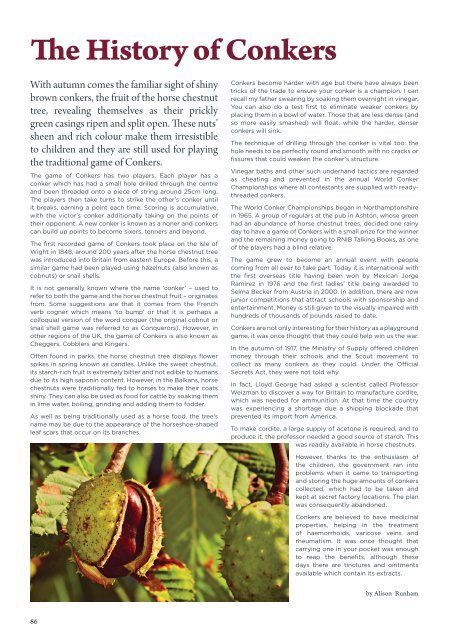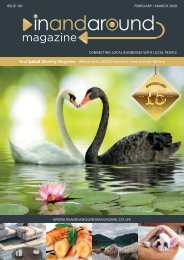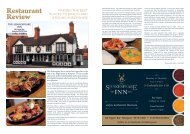I and A Mag Sep19
Telford Magazine
Telford Magazine
Create successful ePaper yourself
Turn your PDF publications into a flip-book with our unique Google optimized e-Paper software.
The History of Conkers<br />
With autumn comes the familiar sight of shiny<br />
brown conkers, the fruit of the horse chestnut<br />
tree, revealing themselves as their prickly<br />
green casings ripen <strong>and</strong> split open. These nuts’<br />
sheen <strong>and</strong> rich colour make them irresistible<br />
to children <strong>and</strong> they are still used for playing<br />
the traditional game of Conkers.<br />
The game of Conkers has two players. Each player has a<br />
conker which has had a small hole drilled through the centre<br />
<strong>and</strong> been threaded onto a piece of string around 25cm long.<br />
The players then take turns to strike the other’s conker until<br />
it breaks, earning a point each time. Scoring is accumulative,<br />
with the victor’s conker additionally taking on the points of<br />
their opponent. A new conker is known as a noner <strong>and</strong> conkers<br />
can build up points to become sixers, tenners <strong>and</strong> beyond.<br />
The first recorded game of Conkers took place on the Isle of<br />
Wight in 1848, around 200 years after the horse chestnut tree<br />
was introduced into Britain from eastern Europe. Before this, a<br />
similar game had been played using hazelnuts (also known as<br />
cobnuts) or snail shells.<br />
It is not generally known where the name ‘conker’ – used to<br />
refer to both the game <strong>and</strong> the horse chestnut fruit – originates<br />
from. Some suggestions are that it comes from the French<br />
verb cogner which means ‘to bump’ or that it is perhaps a<br />
colloquial version of the word conquer (the original cobnut or<br />
snail shell game was referred to as Conquerors). However, in<br />
other regions of the UK, the game of Conkers is also known as<br />
Cheggers, Cobblers <strong>and</strong> Kingers.<br />
Often found in parks, the horse chestnut tree displays flower<br />
spikes in spring known as c<strong>and</strong>les. Unlike the sweet chestnut,<br />
its starch-rich fruit is extremely bitter <strong>and</strong> not edible to humans<br />
due to its high saponin content. However, in the Balkans, horse<br />
chestnuts were traditionally fed to horses to make their coats<br />
shiny. They can also be used as food for cattle by soaking them<br />
in lime water, boiling, grinding <strong>and</strong> adding them to fodder.<br />
As well as being traditionally used as a horse food, the tree’s<br />
name may be due to the appearance of the horseshoe-shaped<br />
leaf scars that occur on its branches.<br />
Conkers become harder with age but there have always been<br />
tricks of the trade to ensure your conker is a champion. I can<br />
recall my father swearing by soaking them overnight in vinegar.<br />
You can also do a test first to eliminate weaker conkers by<br />
placing them in a bowl of water. Those that are less dense (<strong>and</strong><br />
so more easily smashed) will float, while the harder, denser<br />
conkers will sink.<br />
The technique of drilling through the conker is vital too: the<br />
hole needs to be perfectly round <strong>and</strong> smooth with no cracks or<br />
fissures that could weaken the conker’s structure.<br />
Vinegar baths <strong>and</strong> other such underh<strong>and</strong> tactics are regarded<br />
as cheating <strong>and</strong> prevented in the annual World Conker<br />
Championships where all contestants are supplied with readythreaded<br />
conkers.<br />
The World Conker Championships began in Northamptonshire<br />
in 1965. A group of regulars at the pub in Ashton, whose green<br />
had an abundance of horse chestnut trees, decided one rainy<br />
day to have a game of Conkers with a small prize for the winner<br />
<strong>and</strong> the remaining money going to RNIB Talking Books, as one<br />
of the players had a blind relative.<br />
The game grew to become an annual event with people<br />
coming from all over to take part. Today it is international with<br />
the first overseas title having been won by Mexican Jorge<br />
Ramirez in 1976 <strong>and</strong> the first ladies’ title being awarded to<br />
Selma Becker from Austria in 2000. In addition, there are now<br />
junior competitions that attract schools with sponsorship <strong>and</strong><br />
entertainment. Money is still given to the visually impaired with<br />
hundreds of thous<strong>and</strong>s of pounds raised to date.<br />
Conkers are not only interesting for their history as a playground<br />
game, it was once thought that they could help win us the war.<br />
In the autumn of 1917, the Ministry of Supply offered children<br />
money through their schools <strong>and</strong> the Scout movement to<br />
collect as many conkers as they could. Under the Official<br />
Secrets Act, they were not told why.<br />
In fact, Lloyd George had asked a scientist called Professor<br />
Weizman to discover a way for Britain to manufacture cordite,<br />
which was needed for ammunition. At that time the country<br />
was experiencing a shortage due a shipping blockade that<br />
prevented its import from America.<br />
To make cordite, a large supply of acetone is required, <strong>and</strong> to<br />
produce it, the professor needed a good source of starch. This<br />
was readily available in horse chestnuts.<br />
However, thanks to the enthusiasm of<br />
the children, the government ran into<br />
problems when it came to transporting<br />
<strong>and</strong> storing the huge amounts of conkers<br />
collected, which had to be taken <strong>and</strong><br />
kept at secret factory locations. The plan<br />
was consequently ab<strong>and</strong>oned.<br />
Conkers are believed to have medicinal<br />
properties, helping in the treatment<br />
of haemorrhoids, varicose veins <strong>and</strong><br />
rheumatism. It was once thought that<br />
carrying one in your pocket was enough<br />
to reap the benefits, although these<br />
days there are tinctures <strong>and</strong> ointments<br />
available which contain its extracts.<br />
by Alison Runham<br />
86










